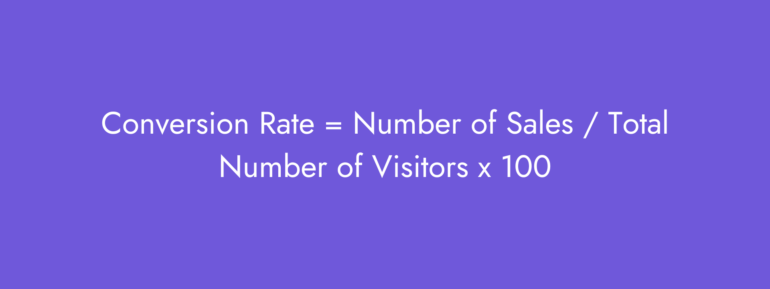The retail conversion rate is one of the most important metrics for online retailers. It measures how many visitors buy something and helps you understand how effective your marketing strategies are at converting visitors into paying customers. But what exactly does conversion rate mean, and why does it matter? In this article, we’ll dive into the basics of calculating retail conversion rates and explore some strategies on how to increase conversion rates in retail.
What is Conversion Rate in Retail & Why is it Important?
A conversion rate is the percentage of people who purchase a product from your store. It shows how many people out of your total users buy something and convert into customers.
Conversion rates are important because they can help you determine how effective your marketing campaigns are and how well you are meeting customer needs. They also help you improve those areas that aren’t working as well as they should be. For example, if a large percentage of potential customers are abandoning their shopping cart before completing payment, this information can help you identify and address any problems with your checkout process.
How to Calculate Conversion Rates in Retail
The conversion rate is the percentage of visitors who buy something. This can be calculated by dividing the number of transactions (the number of sales) by the number of visits to your site. Here is the retail conversion rate formula:

To calculate this, you need to know how many transactions and visitors there were in a certain period.
Digi-Tip: To do this, you can use a simple spreadsheet or use any statistics software like Google Analytics.
Keep in mind that when one person buys three separate items, it counts as one sale.
For example, if you have 1,000 visitors to your store and about 100 people make a purchase, your retail conversion rate would be 10% (100/1000*100).
What is a good conversion rate in retail? The average conversion rate for the retail industry is between 20% and 40%.
Track Conversion Rates Over Time
Tracking your website’s conversion rates over time is important for identifying trends and areas for improvement.
Are you seeing an increasing number of visitors to your site over time? If so, this could mean that your marketing efforts are paying off and you are reaching more people with each campaign.
Is there a particular day of the week when most people convert on your site? If so, it may be worth focusing more energy on that day.
Are there certain times of the year when conversions are lower than usual (such as during holiday shopping seasons)? You may want to consider adjusting prices or advertising campaigns accordingly to boost sales during these slower periods to compensate for any losses incurred as a result of low traffic volume at other times throughout the year.
Factors That Impact Conversion Rates
Here are some of the factors that impact conversion rates in retail.
Website design and usability: A website’s design can make or break a visitor’s experience. A good-looking site is more likely to attract customers, while a hard-to-navigate website will turn them away. Remember that when your website is not optimized for mobile as well, customers will leave it very quickly.
Digi-Tip: Make sure your website doesn’t take too long to load (max. 3 seconds) since it will make users leave it.
Poorly optimized pages: Once your pages are not SEO-friendly, your website won’t rank high on search engines, which means that people won’t find your website. Hence, you will have lower conversion rates in retail.
Pricing and shipping information: If it takes too long for people to find out how much something costs and how long it’ll take for them to get their item after ordering, they’ll probably go somewhere else instead of waiting around for an answer.
Calls to action (CTAs): CTAs tell visitors what action needs to be taken next, such as “Buy Now” or “Contact Us.” Visitors need clear instructions on what comes next before purchasing so that there are no surprises along the way.

How to Increase Store Conversion Rate?
When increasing conversion rates in retail, consider the following:
1. Encourage Purchases
Offering free shipping or other incentives is a good way of encouraging people to purchase on your site. It also provides an opportunity for you to gather information about what people are buying, which can help improve future sales.
If a customer buys three products, for example, you could offer them free shipping on their fourth item to encourage them to buy again and ensure that they won’t need to pay for shipping next time around.
2. Consider Customer Feedback
By monitoring customer feedback and comments on social media, you’ll be able to take note of any issues with your product descriptions or checkout process that may have caused problems with conversion rates in the past (e.g., if someone found it difficult getting through checkout). By fixing these issues now before they become bigger, you can increase overall sales without having too much effect on profits as well.
3. Attracting Customers
You can attract customers by positioning products in the right way. For example, let’s say you have a new product. You need to put it on the top so that new items are visible. Also, you need to refresh your website frequently because website redesign will attract new customers.
4. Make Your Website SEO-friendly
You need to do proper keyword research and write the descriptions of your products by having SEO in mind. Remember that no one will buy your product if they don’t see it. Want to make it visible? Then, use SEO. Make your store easy to find on search engines like Google, and Yahoo, by optimizing your store name and meta tags (keywords) so they show up in search results under appropriate headings such as “shopping,” “shopping carts,” or “online shopping.”
5. Improve User Experience
Though this is a part of the above-mentioned points, we feel like it needs extra attention. A good user experience makes shopping easier and more enjoyable for customers. This can be achieved through several tactics, including
- Streamlining navigation so shoppers don’t have trouble finding items they want to buy or putting in their order.
- Ensuring products are easy to find.
- Providing tools like wish lists and product reviews that help customers make informed purchasing decisions.
- Adding value with shipping options (such as free shipping), price comparison tools, in-store pickup options, etc.
6. Boost Social Presence
Also, use social media sites like Instagram and Facebook as another way of getting people interested in visiting your website — these sites have millions of users who might be interested in purchasing products online. Be active and boost your social presence since it’s the best place to communicate with your customers directly.

7. Make it Mobile-friendly
Use a mobile-friendly shopping store. Make sure it’s easy to navigate with a smartphone or tablet, especially if you’re targeting a younger generation of buyers who are accustomed to using mobile devices more than desktop computers.
8. Simplify Checkouts
No one will go till the checking out if the buying process is complex. Optimize the checkout process so that it’s easy and quick for customers to complete their orders. Offer them different payment options.
Calculating and improving your retail conversion rate is an essential part of running a successful business. You can’t improve what you don’t know, so it’s important to measure these key metrics regularly. When you know how much money is coming in from each sale, what your average sales price is and how many items are being sold per customer visit, then you can make educated decisions about where to put your resources.




